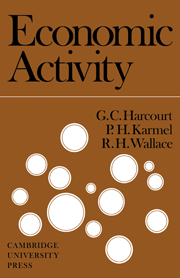Book contents
- Frontmatter
- Preface
- Contents
- 1 INTRODUCTION
- 2 THE NATIONAL ACCOUNTS AND THE INCOME–CREATION PROCESS
- 3 THE PRODUCTION–INCOME–EXPENDITURE CIRCUIT AND NATIONAL ACCOUNTING IDENTITIES
- 4 THE DETERMINATION OF THE EQUILIBRIUM LEVEL OF REAL INCOME
- 5 THE CONCEPT OF FULL EMPLOYMENT
- 6 MONEY IN THE ECONOMIC PROCESS
- 7 THE BANKING SYSTEM AND THE QUANTITY OF MONEY
- 8 THE CONSUMPTION FUNCTION
- 9 THE DETERMINANTS OF INVESTMENT EXPENDITURE
- 10 THE EFFECT OF CHANGES IN EXPENDITURE PLANS: THE MULTIPLIER CONCEPT
- 11 THE GOVERNMENT SECTOR AND THE DETERMINATION OF REAL INCOME
- 12 THE OPEN ECONOMY
- 13 THE INTERACTION BETWEEN PLANNED EXPENDITURES AND FINANCIAL FACTORS
- 14 INFLATION
- 15 ECONOMIC POLICY
- List of suggested reading
- Index
Preface
Published online by Cambridge University Press: 18 December 2009
- Frontmatter
- Preface
- Contents
- 1 INTRODUCTION
- 2 THE NATIONAL ACCOUNTS AND THE INCOME–CREATION PROCESS
- 3 THE PRODUCTION–INCOME–EXPENDITURE CIRCUIT AND NATIONAL ACCOUNTING IDENTITIES
- 4 THE DETERMINATION OF THE EQUILIBRIUM LEVEL OF REAL INCOME
- 5 THE CONCEPT OF FULL EMPLOYMENT
- 6 MONEY IN THE ECONOMIC PROCESS
- 7 THE BANKING SYSTEM AND THE QUANTITY OF MONEY
- 8 THE CONSUMPTION FUNCTION
- 9 THE DETERMINANTS OF INVESTMENT EXPENDITURE
- 10 THE EFFECT OF CHANGES IN EXPENDITURE PLANS: THE MULTIPLIER CONCEPT
- 11 THE GOVERNMENT SECTOR AND THE DETERMINATION OF REAL INCOME
- 12 THE OPEN ECONOMY
- 13 THE INTERACTION BETWEEN PLANNED EXPENDITURES AND FINANCIAL FACTORS
- 14 INFLATION
- 15 ECONOMIC POLICY
- List of suggested reading
- Index
Summary
Economic Activity has its origins in a course of lectures given since 1950 to first-year undergraduates at the University of Adelaide. That course was originally given by P. H. Karmel; in later years the other two co-authors inherited it. Little attention was paid to financial factors in the first-year course. A second-year course of macroeconomics (given on several occasions by R. H. Wallace) was built upon the first course, and in this the inter-relationships between the financial and production sectors of the economy were considered in detail. The second-year course was set in the context of the particular institutional framework of the Australian economy, and students were introduced to the relevant statistical material. The book draws upon material from both courses, but the discussion of the financial sector is essentially theoretical.
The book is Keynesian in spirit, and designed to give a simplified but rounded exposition of the workings of a modern mixed economy. Final drafts of the book were used for this purpose by G. C. Harcourt in a course of lectures given in the Lent and Michaelmas Terms, 1966, to undergraduates taking Part I of the Economics Tripos at the University of Cambridge. However, the book is designed so that it can be used in courses where the financial system is not considered in detail, and in that case chapters 6, 7 and 13 would be omitted. Chapters 4 to 7 and 10 could be used to cover the macroeconomic sections in an introductory survey course of economics.
- Type
- Chapter
- Information
- Economic Activity , pp. v - viPublisher: Cambridge University PressPrint publication year: 1967



